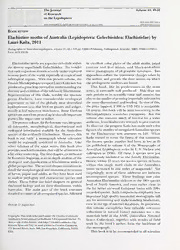
Elachistine moths of Australia (Lepidoptera: Gelechioidea: Elachistidae) by Lauri Kaila, 2011 PDF
Preview Elachistine moths of Australia (Lepidoptera: Gelechioidea: Elachistidae) by Lauri Kaila, 2011
The Journal Volume 44: 49-50 of Research on the Lepidoptera ISSN 0022-4324 (print) I lin l.KIMPOPTF.RA RKSKARCH FOUNDATION, 28 Ai'c.usr 2011 ISSN 213fK>l3" (om^ Book review Elachistine moths of Australia (Lepidoptera: Gelechioidea: Elachistidae) by Lauri Kaila, 2011 Monographs on Australian Lepidoptera, volume 11, viii + 443 pp. CSIRO Publishing, Collingwood, Australia. ISBN: 9780643103054. Price: AU$ 150.00. Elachistidae moths are a species-rich clade within by excellent color plates of the adult moths, pupal the diverse superfamily Gelechioidea. No wonder exuviae and leaf mines, and black-and-white that such organisms remain severely under-explored micro photographs of all genitalic structures. Two in many parts of the world, especially in tropical and appendices collate the taxonomic changes taken by subtropical regions. With this present volume, the the author, and provide the data matrix on which Finnish Microlepidoptera expert Lauri Kaila now has the phylogenetic analyses are based. produced a great leap forward in understanding the This book, like its predecessors in the same diversity and evolution of the subfamily Elachistinae. series, is extremely well produced. This does not Representatives of this clade, notably the speciose only pertain to its scientific value and content, but genus Elachista, have considerable ecological also to the quality of printing (especially relevant for importance as one of the globally most diversified the many illustrations) and binding. In view of this, lepidopterous taxa that feed on grasses and sedges, the price (approx. € 100 or US$ 145) is acceptable. usually as leaf miners or stem borers. Some Elachista Of course, this book will be most interesting to the species are notorious pests of agriculturally important Microlepidoptera researcher community. But this grasses like sugar cane or millet. volume also contains much of interest for a wider The present volume, for the first time ever, integrates audience, from biodiversity research to pest control. all taxonomic, morphological, distributional and To illustrate the progress Kaila has made with a few ecological information available for the Australian figures: the number of recognized Australian species species of the subfamily Elachistinae. However, this in the Elachistinae now amounts to 148. When book is not ‘only’ a monograph whose relevance Kaila started to revise the fauna of that continent, wotdd be regionally restricted to Australia. Like the known species number had been as low as 19 other volumes of the same series, this book also (as published in volume 4 of the Monographs of provides much information that will be of interest to Australian Lepidoptera series by E. S. Nielsen and a far wider readership. The first chapter, co-authored colleagues in 1996). Of these, 5 species were just erroneously included in the family Elacistidae. by Kazuhiro Sugisima, is an in-depth analysis of the Hence, within 15 years the known species richness phylogeny and classification of Elachistinae under a within this single moth clade in the Australian global perspective. The second chapter introduces in fauna increased by one order of magnitude! Not detail the morphological and anatomical structures surprisingly, most of these additions are hitherto of larvae, pupae and adults, as they have been used unrecognized species. These findings now raise to analyze phylogeny and characterize species and Australian Elachistidae richness to the 140+ species clades. There follow two brief chapters on general level of North America, and even rather close to elachistid biology and on their distribution within the far better surveyed European fauna with 200+ Australia. The main part of the book contains recorded species. Such comparisons emphasize how detailed accounts of all recognized species, followed important high quality taxonomic monographs still are for uncovering and understanding biodiversity, even in the age of internet databases. In particular, Received: 11 August 2011 this volume exemplifies how valuable reference collections in natural history museums are - the Copyright: This work is licensed under the Creative Commons materials held in the ANIC (Australian National Attribution-NonCommercial-NoDerivs 3.0 Unported License. To Insect Collection), together with results of field view a copy of this license, visit http://creativecommons.org/ work by the book’s author, form the backbone of licenses/by-nc-nd/3.0/ or send a letter to Creative Commons, this monograph. 171 Second Street, Suite 300, San Francisco, California, 94105, USA. This book is to be recommended to all scientists 50 /. Res.Lepid. with interest in the systematics and biogeography of the documentation of Lepidopteran diversity of the Microlepidoptera. It should definitely be available in Australian continent. any larger museum or university library. Moreover, Konrad Fiedler, Department of Animal Biodiversity, University of one is inclined to hope that further such volumes will Vienna, Austria. continue to appear in that series, in order to improve konrad.p.edler@univie. ac. at
